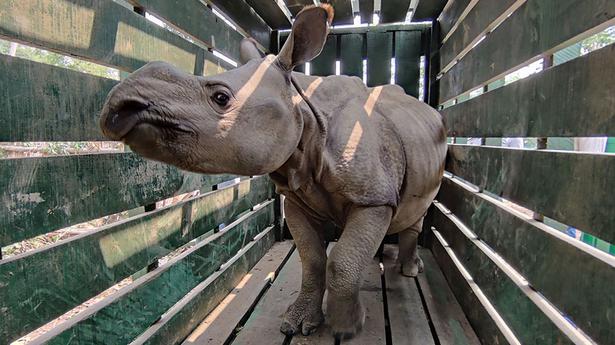
Rhino reintroduction success in Assam
The Hindu
Manas National Park rhinos have higher life expectancy but need translocation support, reveals latest census
The one-horned rhinos of western Assam’s Manas National Park, bordering Bhutan, have an age structure pyramid, indicating higher life expectancy and significant growth in the population.
On the flip side, the 500-sq.-km park does not have “a wider representation of calves and sub-adults” to sustain the population structure unless it is supplemented through conservation translocations, the 14 th Assam rhino estimation conducted in April has revealed.
Manas, a UNESCO World Heritage Site and a tiger reserve, had about 100 resident rhinos prior to 1990, but a prolonged ethno-political conflict thereafter took a heavy toll with extremist groups known to have traded the horns of the herbivores for weapons.
A rhino reintroduction programme under the Indian Rhino Vision 2020 was started in 2006. This entailed the translocation of rhinos from Kaziranga National Park and Pobitora Wildlife Sanctuary besides orphans hand-reared at the Centre for Wildlife Rehabilitation and Conservation at Kaziranga.
The current rhino population in the park was estimated at 40 after the census on April 1 and 2.
A detailed census report by Vaibhav C. Mathur, the field director of Manas, said the park’s rhinos have a male-female sex ratio of 1:1, arrived at without considering 10 calves and five sub-adults.
“The number of calves born in the wild reflects the availability of welfare factors to foster rhinos in Manas National Park,” said the report, obtained through RTI by environment activist Rohit Choudhury.

“Writing, in general, is a very solitary process,” says Yauvanika Chopra, Associate Director at The New India Foundation (NIF), which, earlier this year, announced the 12th edition of its NIF Book Fellowships for research and scholarship about Indian history after Independence. While authors, in general, are built for it, it can still get very lonely, says Chopra, pointing out that the fellowship’s community support is as valuable as the monetary benefits it offers. “There is a solid community of NIF fellows, trustees, language experts, jury members, all of whom are incredibly competent,” she says. “They really help make authors feel supported from manuscript to publication, so you never feel like you’re struggling through isolation.”

Several principals of government and private schools in Delhi on Tuesday said the Directorate of Education (DoE) circular from a day earlier, directing schools to conduct classes in ‘hybrid’ mode, had caused confusion regarding day-to-day operations as they did not know how many students would return to school from Wednesday and how would teachers instruct in two modes — online and in person — at once. The DoE circular on Monday had also stated that the option to “exercise online mode of education, wherever available, shall vest with the students and their guardians”. Several schoolteachers also expressed confusion regarding the DoE order. A government schoolteacher said he was unsure of how to cope with the resumption of physical classes, given that the order directing government offices to ensure that 50% of the employees work from home is still in place. On Monday, the Commission for Air Quality Management in the National Capital Region and Adjoining Areas (CAQM) had, on the orders of the Supreme Court, directed schools in Delhi-NCR to shift classes to the hybrid mode, following which the DoE had issued the circular. The court had urged the Centre’s pollution watchdog to consider restarting physical classes due to many students missing out on the mid-day meals and lacking the necessary means to attend classes online. The CAQM had, on November 20, asked schools in Delhi-NCR to shift to the online mode of teaching.









